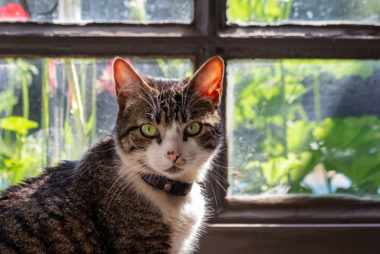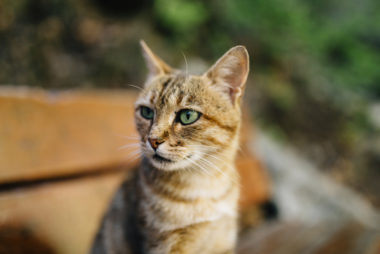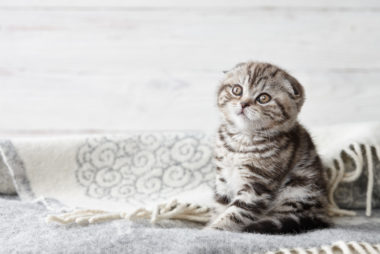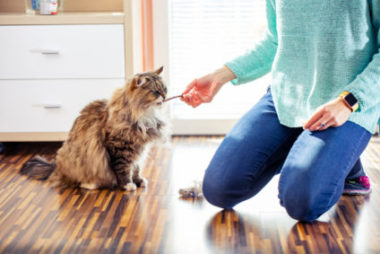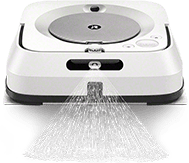15 Medium-Haired Cat Breeds To Know About
There’s just something about a fluffy cat that drives us cat people wild. Can you really blame us though? With the range of exotic colors and patterns, the softest tresses you can pet, and a poofiness that make you instantly want to cuddle them? The question is: how do you choose? Which medium-haired cat breed is really right for you and your home or lifestyle?
It sounds like an odd question. But, if you have allergies, want the long hair without the shedding, or live in a very warm or cold climate, you may want to consider a few things before you pick just any lucky cat.
We’re covering some of the most beautiful and popular medium-haired cats, what makes them so, and all their lovely characteristics for you to consider.
What qualifies as a medium-haired cat? Shorthair cat? Longhair cat?
When you’re booking a visit to the vet, they’ll likely ask you if your cat is long, medium, or short-haired. And maybe you’re just set on getting a certain sort of cat, and want to make sure you find the one that really suits you…
Either way, it’s not always easy for pet parents (or even cat lovers) to tell what each cat qualifies as – in terms of hair length.
Got a cat dad in your life?
Check out these gift ideas for dads of any cat breed
Here’s how to tell the difference:
- The domestic short-hair cat breeds– will clearly have short hair, but the main distinguisher is that they won’t have excess or longer hairs around their legs, heads, and tails.
- The domestic medium-hair cat breeds– are a cross between short and long-haired cats, having shorter hair along their spines and faces but longer hairs around their necks and bellies.
- The domestic long-hair cat breeds– have a very uniform coat that is long (typically the same length hairs) across their entire body.
Something to note here: none of these designations qualify as a breed in and of themselves. Instead, they’re more like descriptors, with certain breeds generally fitting within them.
What’s the difference in shedding?
It may look like medium or longer-haired cats would shed more than short-haired cats, but that simply isn’t true.
Think of them as humans, in a way. We all shed our hair each and every day, whether our hair is long or short. The difference is that long hairs are easier to notice… in the drain, on pillows, stuck in your partner’s beard… The long hairs just stand out a bit more.
That said, there’s something else to remember here:
Some cats are considered “hypoallergenic”.
Yes, even long and medium-haired cat breeds can be hypoallergenic. This is because it’s more about a cat’s saliva and dander, which harbor a certain protein that some people are allergic to.
Hypoallergenic cats DO shed less, which helps reduce your allergies because that protein doesn’t spread, but that’s not what gives them the classification.
This means you can get a medium-haired cat that doesn’t shed much… or at least, doesn’t shed more than any non-hypoallergenic cat.
Want truly non-hypoallergenic?
15 Domestic medium-hair cat breeds to know about
You want a fluffy kitty, but maybe one that’s not overly fluffy, that would be treading into long-hair territory… And for some people, that’s just a little too far. No worries. There are actually plenty of cat breeds and varieties whose hair is not too short, not too long. They’re just right!
We’ve pulled together some of the most popular and puuuurty domestic medium-haired cats available.
Keep in mind, that most house cats are not purebred and if you adopt, odds are your cat will be a mix of breeds – and those mixes often result in medium hair. They’re hanging out at the shelter, or your neighborhood cat cafe (if you’re lucky enough to have one).
**Clears throat for roll call*
They are as follows:
1. Abyssinian
While most Abyssinian cats have short hair, the breed can stretch into the medium-haired territory, and it’s a good thing they do because you don’t want to miss out on this interesting breed.
They’re incredibly smart, and easily trainable, making them really great companions for those that want a cat who lives a little more on your terms than others.
Abyssinians are not super cuddly though, so don’t expect them to sit on your lap and lay with you frequently. Even with other cats, they may not get along, as they’ll tend to bond with one family member and ignore the rest.
As far as their hair goes, it’s “ticked” which means that the ends are a bit darker than the stem of the hair. Each individual hair carries both light and dark bands.
Now, there aren’t a ton of Abyssinian rescues to adopt in most places, but if you want a purebred kitten you may have to travel to find one. They also tend to be expensive, with the breeder costs ranging from $1500-to 2000.
2. American Wirehair
As the name suggests, an American Wirehair cat has wiry hair that’s often likened to a soft Brillo pad. Now, no one hears Brillo pad and thinks soft and cuddly, but this kitty is exactly that.
The texture of their wire hairs can range, but they tend to maintain the same texture. Luckily, these hairs don’t mat, so these are cats that don’t shed as much.
They look a little wild and have very wild and fun personalities. This has given them a reputation as the “punks” of the animal world.
Since they’re almost always kept for show or breeding, they can be a bit hard to find. It’s also considered a fairly rare cat since it’s caused by a genetic mutation.
Even if your cat sheds, it doesn’t have to show.
3. Bengal
While Bengal cats look very similar to the tabby, they’re actually pretty unique because they contain wildcat leopard DNA and are a fairly new breed (cross-bred in the 1960s).
Because of their close DNA to leopards, they tend to have the same recognizable spots (rosettes).
They can be a bit wild in personality, shy, and quite demure, but if they’re generationally removed far enough from the leopard they’ll be more comfortable being an indoor cat.
4. Bobtail
Recognized by their short tails (hence, bobtail), this beautiful cat is one of the more personable breeds on this list.
They’re actually a favorite travel companion for long-haul truckers because they travel better than other cat breeds– as long as you introduce them to cars/ trucks early in their lives.
Interestingly, they’re also commonly used as psychotherapy cats because they tune into human emotions really well, and can sense when someone is stressed.
As another relatively new breed (discovered on a Native American reservation in the 60s)– and since the demand is so high – there’s a waitlist with breeders and they can be slightly hard to find.
Looking for our best robot vacuum for cat hair?
5. American Burmese
The American Burmese cats are descendants of the Siamese cat breed (and also similar to a Birman in pattern and color, though a Birman will have longer hair), and may be mistaken for such since they have similar color patterns – with their extremities darker and body lighter.
The difference is, that they tend to have much darker hair overall, compared to the white-bodied Siamese.
Burmese cats also tend to be rather compact, yet are deceptively muscular (making them heavier than you’d think).
Their fur is extremely soft and silky and can be long or short. Either way, they don’t shed much and really only need to be groomed once a week.
6. Cyprus
Cyprus cats are considered an ancient breed, thought to have been brought to Cyprus by St. Helen. Because they’re an old breed, they’re pretty common as domesticated cats.
They don’t have a set personality, and they don’t really have a definitive color. What does distinguish them is a rather large, muscular body (weighing up to 16 pounds) and a thick layer of medium-long hair, which can also be short but still remains thick.
7. Egyptian Mau
Another extremely old breed, the Egyptian Mau is the only naturally spotted domesticated cat. There was no breeding involved to give this breed its distinctive pattern. Another distinguishing feature is their long, sleek body.
They’re pretty fast cats, and vocal when they’re happy. They’re also known for being very active and playful. If you don’t have a lot of time for this loyal cat, it might not be the choice for you.
How do you remove cat hair from a Persian rug?
Check out these 11 DIY Persian rug cleaning tips for cat owners
8. LaPerm
The LaPerm is named such because of its adorable fluffy curls that look very similar to a short-haired perm just out of the salon. While the curly hair is distinctive, its variety of colors and patterns vary wildly.
It’s a relatively small cat, only growing to about 8 pounds, which is fun for those that want a small, light cat that’s playful. When we say playful, we also mean a bit sneaky. They tend to swipe things and generally try to open doors or attract your attention in odd ways.
9. Manx
The Manx has either a calico or tabby pattern and coloring, but that doesn’t mean you can’t distinguish them from any other cat. They’re born with a deformity that makes it look as if they don’t have a tail at all (or just have a little nub).
They’re incredibly friendly cats, bond well with people, and tend to follow cat owners around.
10. Scottish Fold
The Scottish Fold is a rare, rather new breed and is called such because of their short, folded ears. They are actually born with straight ears that might start to fold over at around 4 weeks. Some may never fold at all. Either way, let’s be honest, they’re still incredibly adorable.
Their fur is dense, plush, and tends to look as though they’ve rolled around on a staticky balloon. They often possess different colors and patterns, this is because they’re bred with other cat breeds to avoid certain genetic disorders.
They’re very loyal cats, choosing a favorite person in the house, though they won’t shy away from others.
Are your vinyl floors taking a beating?
11. Siberian
Siberians are very similar to Himalayans or Ragdoll cats (and like the Siberian husky dog breed), tending to have long, poofy, but extremely soft coats of fur.
The difference is that some may have short hair (especially in the summer). They’re also rather large and heavy cats, generally growing to about 20 pounds.
They make great companions, often greeting you at the door and following you around the house. They’re affectionate, but not overly clingy.
12. Somali
Somali cats are very similar in body style to the Abyssinian since they’re a variety of the Abyssinian. The difference is that they were bred with longer-haired cat breeds, and have a distinctive ruff around their neck.
They tend to be lively and attentive, and even clever, often getting into things around the house or watching you go about your day. They’re often great with dogs and active children and can match their energy.
13. Tonkinese
The Tonkinese is a crossbreed of the Siamese and Burmese, and look rather similar to the Siamese, though they could come in all white, and may have blue eyes. They generally have short hair, but there are a few types with medium-length hair.
They are extremely affectionate cats and tend to need a lot of attention. They may follow you around the house until they get the attention they crave. If you’re not home very often, this may not be the cat for you.
14. Turkish Angora
The Turkish Angora is a nationally loved cat, with distinctive white, fluffy fur (though they can come in different colors). They’re fairly muscular, but small, making them look delicate.
A stubborn cat, but very charming and intelligent. It’s a very playful cat, who can be highly interactive and can get into trouble trying to get your attention. If you’re not home during the day, the Angora is better off if you have another pet to keep them company.
15. Turkish Van
Though this breed is ancient, it’s a bit rare because they are rarely ever bred with other breeds of cats.
They’re distinguished by their white body and color only on their head and tail, generally brown. They often have eyes of two different colors, which is unusual across most other breeds but common for the Van.
Another unusual thing about the Turkish Van is that they’re known to like water (at least in general). They also really enjoy playing games, so if have time and want a great companion, this may be the cat for you.
Don’t forget, you CAN have laminate floors that shine.
Which medium-haired cats are hypoallergenic?
Technically, there is no such thing as a hypoallergenic cat. As mentioned earlier, allergies are caused by a protein that all cats produce. Some cats simply produce less of that protein.
The reason allergies are associated with their hair is that the protein from their skin is carried on their fur and dander, reaching you through the air and on surfaces.
That said, there are medium-haired cat breeds that shed less than others (even their short-haired counterparts).

- LaPerm
- Burmese
- Bengal
- Siberian
If you’re looking for a fluffy, lovable feline friend that doesn’t shed much, those are some of your best bets. But don’t neglect the other breeds above. They may be just the type of cat you were always meant to have.
Remember, most cats you come into contact with are not purebreds. They’re generally a beautifully, varied mix of a few different breeds. Therefore, they tend to have a perfect blend of playful and loving personalities of their own. So, if you’re thinking of becoming a cat parent, your best option may be waiting for you at your local animal shelter, or animal protective league.



